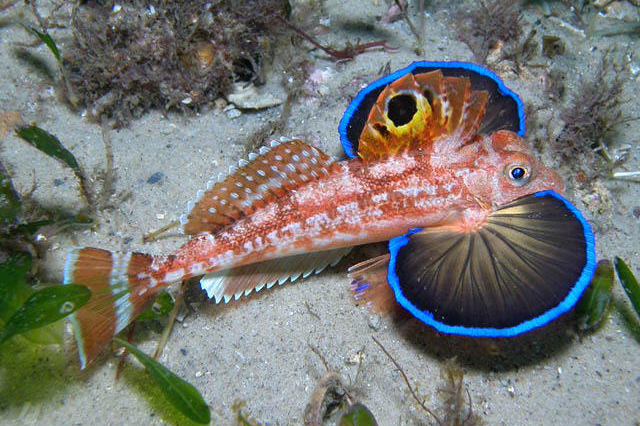Spiny Gurnard, Lepidotrigla papilio (Cuvier 1829)
Other Names: Butterfly Gurnard, Eastern Spiny Gurnard, Southern Spiny Gurnard

A Spiny Gurnard, Lepidotrigla papilio, at Fly Point, Nelson Bay, NSW, Australia. Source: Dave Harasti / http://www.daveharasti.com/. License: All rights reserved
Summary:
A reddish to brownish gurnard, with a whitish underside, a prominent black ocellus on the first dorsal fin, and large bony scutes along the lateral line. The inner surface of the large fan-like pectoral fin is dark green with an iridescent blue margin and a dark blotch on the lower rear of fin. Small juveniles have a prominent ocellus on the inner surface of the pectoral fin.
Cite this page as:
Bray, D.J. 2023, Lepidotrigla papilio in Fishes of Australia, accessed 27 Jun 2025, https://fishesofaustralia.net.au/Home/species/3754
Spiny Gurnard, Lepidotrigla papilio (Cuvier 1829)
More Info
|
Distribution |
Widespread in the southern half of Australia, from off Fraser Island, Queensland, to off Lancelin, Western Australia, including around Tasmania. Inhabits shelly and sandy areas in bays and coastal waters, usually at depths above 50 m; juveniles sometimes in seagrass beds. This is the most frequently encountered species of the genus in southern waters. |
|
Features |
Dorsal fin VIII-IX + 13-15; Anal fin 14-15; Caudal fin 11; Pectoral fin 11 + 3; Pelvic fin I, 5; Lateral line scales 54-60. Head large, bony, border of snout almost smooth; lateral profile of snout very slightly concave; interorbital extremely depressed; deep transverse groove above and behind eye, grooves meeting on top of head; bony rostrum with only slight medial notch, each side edged with tiny peripheral spines. Scales, ctenoid, firmly attached, not on chest and belly anteriorly; lateral line scales greatly enlarged, each with several distinct spines; caudal-fin margin straight; pectoral-fin tip to well past anal-fin origin. |
|
Colour |
Usually red, mottled with reddish brown to dark brown on back and dorsal fins, whitish ventrally; roof of mouth mostly orange; first dorsal fin with large, white-edged, black spot; caudal fin brownish with whitish band basally; inner surface of pectoral fin dark green with narrow blue margin. Small juveniles with prominent ocellus on inner surface of pectoral fin. |
|
Remarks |
Spiny Gurnards usually 'walk' over the seafloor using their free thickened pectoral-fin rays. |
|
Etymology |
The specific name is from the Latin papilio (= butterfly), possibly in reference to the large wing-like pectoral fins that resemble butterfly wings. |
|
Species Citation |
Trigla papilio Cuvier 1829, Histoire Naturelle des Poissons 4: 80, pl. 73(-77). Type locality: Indian seas [Australia]. |
|
Author |
Bray, D.J. 2023 |
|
Resources |
Spiny Gurnard, Lepidotrigla papilio (Cuvier 1829)
References
Cuvier, G.L. in Cuvier, G.L. & Valenciennes, A. 1829. Histoire Naturelle des Poissons. Paris : Levrault Vol. 4 518 pp. pls 72-99. (described as Trigla papilio, Trigla phalaena and Trigla sphinx)
Edgar, G.J., Last, P.R. & Wells, M.W. 1982. Coastal Fishes of Tasmania and Bass Strait. Hobart : Cat & Fiddle Press 175 pp. (as (as Paratriglia papilio)
Gomon, M.F. 1994. Family Triglidae. pp. 494-505 figs 442-450 in Gomon, M.F., Glover, C.J.M. & Kuiter, R.H. (eds). The Fishes of Australia's South Coast. Adelaide : State Printer 992 pp. 810 figs.
Gomon, M.F. & Last, P.R. 2008. Family Triglidae. pp. 508-514 in Gomon, M.F., Bray, D.J. & Kuiter, R.H. (eds). Fishes of Australia's Southern Coast. Sydney : Reed New Holland 928 pp.
Hutchins, J.B. & Swainston, R. 1986. Sea Fishes of Southern Australia. Complete field guide for anglers and divers. Perth : Swainston Publishing 180 pp.
Johnson, J.W. 1999. Annotated checklist of the fishes of Moreton Bay, Queensland, Australia. Memoirs of the Queensland Museum 43(2): 709-762.
Kuiter, R.H. 1993. Coastal Fishes of South-eastern Australia. Bathurst : Crawford House Press 437 pp. (as Lepidotrigla pleuracanthica)
Kuiter, R.H. 1996. Guide to Sea Fishes of Australia. A comprehensive reference for divers and fishermen. Sydney, NSW, Australia : New Holland Publishers xvii, 434 pp. (as Lepidotrigla pleuracanthica, and L. papilio, separating eastern and southern forms into 2 species)
May, J.L. & Maxwell, J.G.H. 1986. Trawl fish from temperate waters of Australia. CSIRO Division of Fisheries Research, Tasmania. 492 pp.
Neira, F.J., Miskiewicz, A.G. & Trnski, T. 1998. Larvae of temperate Australian fishes: laboratory guide for larval fish identification. University of Western Australia Press. 474 pp.
Platell, M.E. & Potter, I.C. 2001. Partitioning of food resources amongst 18 abundant benthic carnivorous fish species in marine waters on the lower west coast of Australia. Journal of Experimental Marine Biology and Ecology 261: 31-54.
Richards, W.J. 1992. Comments on the genus Lepidotrigla (Pisces: Triglidae) with descriptions of two new species from the Indian and Pacific oceans. Bulletin of Marine Science 51(1): 45-65. See ref online
Richardson, J. 1845. Ichthyology. 17-52 pls 7-8 (parts), 11-30 in Richardson, J. & Gray, J.E. (eds). The Zoology of the Voyage of H.M.S. Erebus and Terror under the Command of Captain Sir James Clark Ross, R.N., F.R.S., during the years 1839–43. London : E.W. Janson Vol. 2 139 pp. pls 1-60. (p. 127, described as Trigla pleuracanthica, type locality, Sydney, New South Wales)





